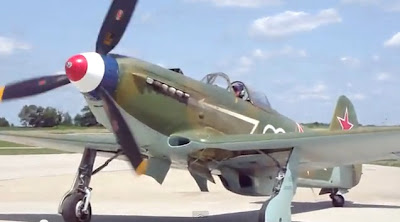Tuesday 21 February 2012
Yak 9 and Yak 3 - best fighters of WW II ?
In June 1941, the German Army swept into Russia. Caught by surprise, Russia's Air Force was largely destroyed on the ground and in the air. Alexander Yakovlev moved his design and manufacturing facilities east of the Ural Mountains and began production of the Yak-9 in 1942. Eventually 16,769 Yak-9 models were built, more than any other aircraft in the Russian Air Force. The Yak-9 was designed for mass production and durability. Due to shortages in Russia, it incorporated a minimum of scarce strategic materials. They were designed to outnumber the enemy, not for technical superiority. While not necessarily out-classing the Fw 190 or even the increasingly obsolescent Bf 109 in its early incarnations, Yakovlev's piston-engined fighters were good fighters in numbers, durable, manoeuvrable, fast, light, capable of absorbing a lot of battle damage and still getting home. The 'T' -tank-destroyer- variant armed with a 37mm cannon packed decent firepower. And appearing during the summer of 1944 the Yak 3 was one of the lightest, fastest most agile fighters of WW II - " perhaps only the Spitfire could rival this machine for manoeuvrability " ( Gordon and Khazanov ). The Fw 190s and Bf 109s were hard-pressed to keep up with the Yak -3 and Jagdwaffe pilots were expressly forbidden from engaging the Yak 3 below certain altitudes. If it had one weakness the wooden Yak 3 offered little protection to its pilot. Even so, 7-victory ace Francois de Geoffre chose not to open his French-language memoir of flying and fighting with the Normandie Niemen with a description of this supreme dogfighter's air combat capabilities - his sortie flown on 23 September 1944 was a successful low-level high speed strafing of Gumbinnen rail station - the first incursion deep into German territory by the Regiment;
" pushing the throttle wide open, and tucked in alongside side each other, our flight of four Yak-3s accelerated down the track and were rapidly airborne. We didn't climb but stayed low. At more than 500 km/h our deadly excursion through West Prussia was underway - 40 minutes of hurdling trees, roads, and villages, leaving our ear-shattering calling cards - the awesome fireworks of four cannon and eight machine guns.."
Here Mark Jeffries flies the Yak 3 at Legends 2008. And some nice high-res still shots from Legends 2010 by Nico - cheers!
-
This page was last updated on 11 November 2021 and currently features 104 images, the majority of which are in my own collection. You can...
-
There were two all-blue RAF F-4 Phantoms - XT 899 was 19 Sqn and XV 408 was 92 Sqn. Unless stated otherwise all photos in my own collection...








